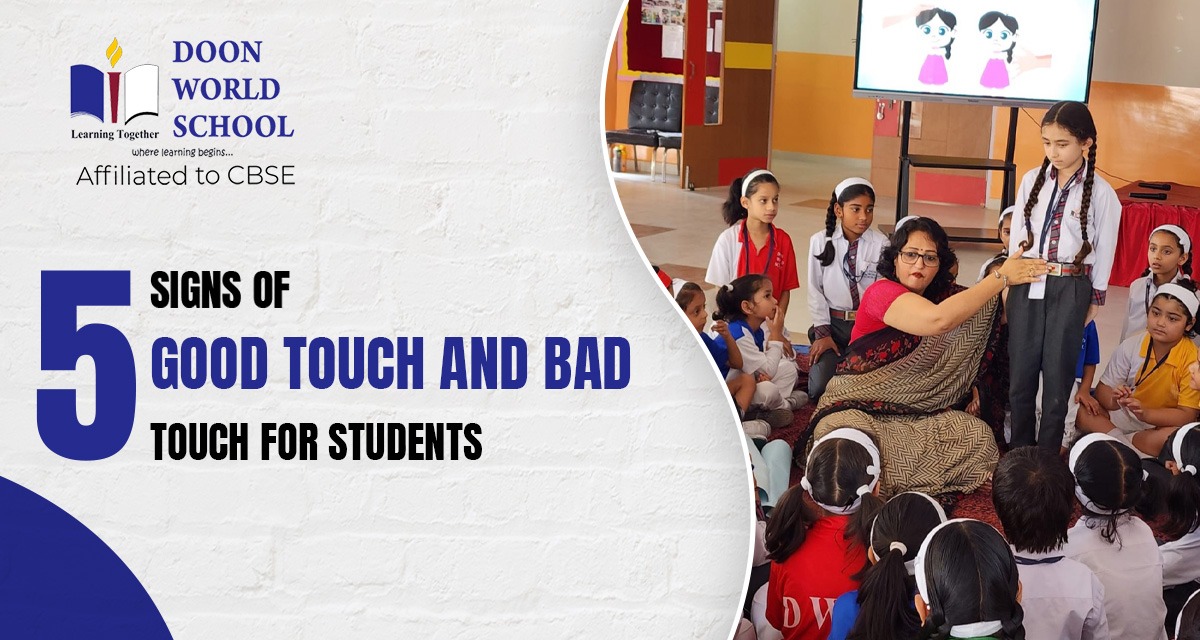
5 Signs of Good Touch and Bad Touch for Students
In today’s world, understanding the difference between signs of good and bad touch is essential for students to maintain their personal safety and emotional well-being. For this reason, we at Doon World School, believe in educating our students about personal boundaries, ensuring they feel empowered to distinguish between safe and unsafe interactions.
Owing to this, here are the five key signs of both good and bad touch to help students navigate their personal space effectively.
1. Comfort vs. Discomfort
Good Touch: A good touch should always make you feel safe, comfortable, and happy. For example, a hug from a parent or guardian when you’re feeling down or a high-five from a friend after doing well in a game can be comforting.
Bad Touch: Bad touch can create feelings of discomfort or anxiety. If someone touches you in a way that feels uncomfortable, even if it’s a pat on the back or a hug you didn’t ask for, it is considered a bad touch. Thus in such situations, listen to your body’s signals; after all, if something feels wrong, it probably is.
2. Respect vs. Violation of Boundaries
Good Touch: A good touch always respects your boundaries. For instance, a friend might ask, “Can I hug you?” or a family member might gently check if you’re okay with physical contact before proceeding. This shows respect for your personal space and comfort.
Bad Touch: In contrast, a bad touch violates those boundaries. If someone touches you without asking or ignores your request to stop, they are crossing a line. Even if they say it’s “just a joke” or “no big deal,” it’s important to recognize that your boundaries have been disrespected.
3. Trust vs. Fear
Good Touch: A good touch comes from people you trust and makes you feel safe, like a teacher’s supportive hand on your shoulder during a difficult time. This kind of touch helps you feel encouraged and understood.
Bad Touch: A bad touch, on the other hand, instills fear. If an adult or peer touches you and makes you feel scared, confused, or threatened—especially in private areas or in a secretive way—this is a sign of bad touch.
4. Transparency vs. Secrecy
Good Touch: A good touch is open and transparent. There’s nothing to hide, and you feel comfortable talking about it with your parents or teachers. For example, hugging your grandparents or holding hands with a close friend is something that feels normal and acceptable.
Bad Touch: A bad touch often comes with secrecy. If someone tells you to “keep this touch a secret” or says that “you’ll get in trouble if you tell anyone,” this is a red flag. No touch should ever be kept secret, especially if it makes you uncomfortable.
5. Positivity vs. Manipulation
Good Touch: A good touch leaves you feeling positive, happy, and cared for. Whether it’s a congratulatory high-five from a teammate or a hug from a family member, a positive touch strengthens your relationships and makes you feel valued.
Bad Touch: A bad touch, however, may come with manipulation. If someone uses guilt or pressure to force you into accepting a touch, that is a sign of manipulation and bad touch. No one should make you feel obligated or guilty for refusing physical contact.
Final Thoughts
Teaching students to understand and recognize the differences between signs of good and bad touch is a crucial part of their development. At Doon World School, we ensure that our students are not only aware of these things but also feel confident in identifying and responding to unsafe situations. We are dedicated to creating a supportive and safe learning environment, where students can grow and learn confidently, knowing their boundaries are respected.


